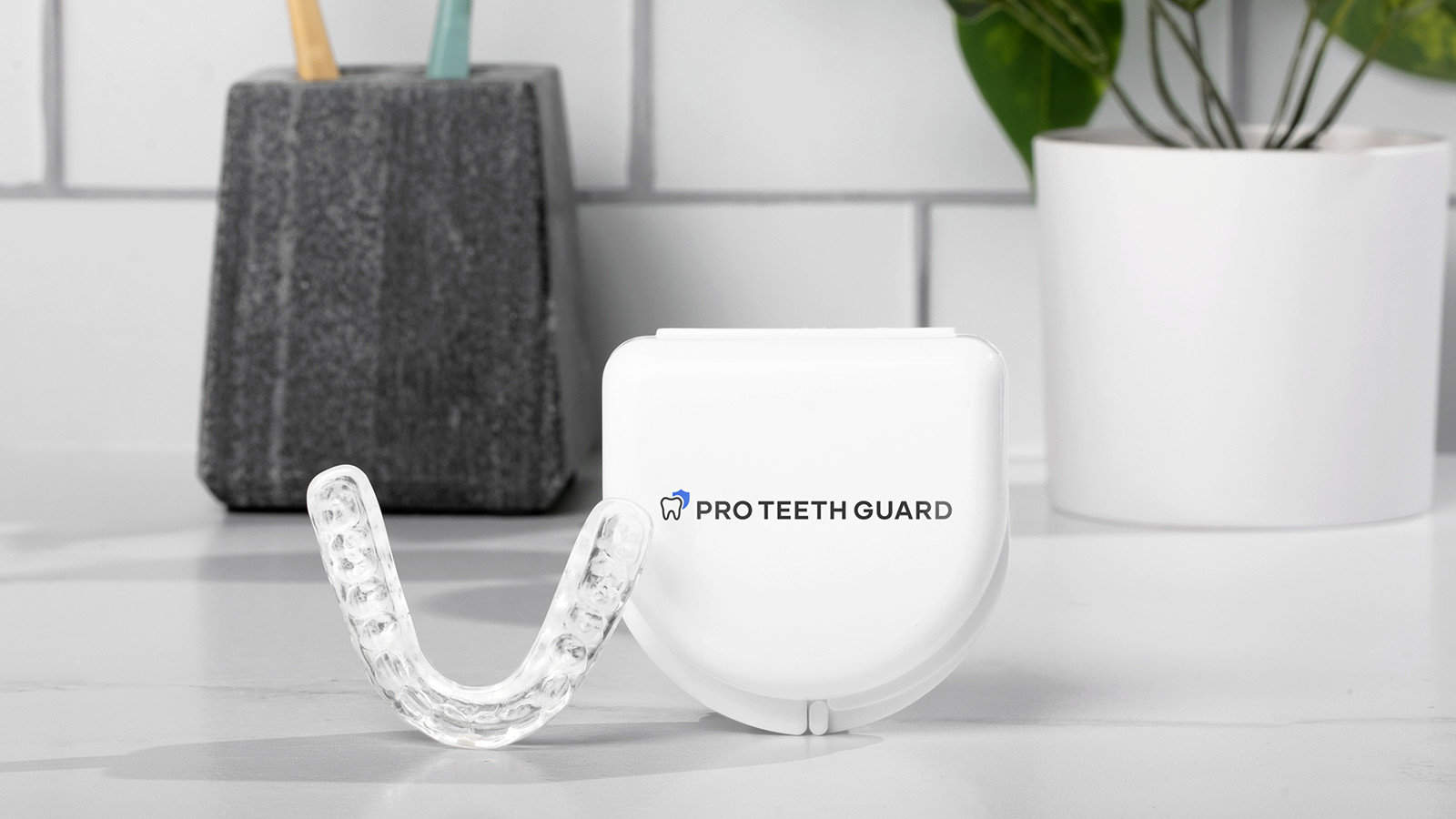Most people use these terms interchangeably, ignoring that they’re two different tools. The two mouth appliances might confuse you about which you require for your orthodontic treatment.
A night guard is created to protect your teeth, while a retainer is meant to maintain how your teeth align. The appliance you need will depend on your situation and what your dental officer recommends.
This article will delve into these dental appliances to help you understand their critical distinctions. We’ll explore which tool you need for whether you’re struggling with teeth grinding or orthodontic maintenance. It will also help you know what you specifically need.
Get ready to make an informed decision that will leave your smile and sleep undeniably protected.
Table of Contents:
Night Guard Essentials for Dental Protection
A night guard is an orthodontic appliance that looks very similar to a retainer. It serves as a protective barrier between the upper and lower teeth, preventing enamel from wear and injury. Bruxism prevention and clenching while sleeping are the main reasons dentists recommend using mouth guards.
Other purposes of a night guard include treating temporomandibular joint (TMJ) disorders, preventing headaches, tooth sensitivity, sleep apnea, tongue biting, etc.
Night guards often involve taking dental impressions and manufacturing a custom-made appliance. In other cases, night guards aren’t the first obvious fix for your dental problem due to active infections or allergies. Here are other ways to prevent bruxism without a night guard. They include:
- Cognitive Behavioral Therapy to treat the underlying cause of bruxism
- Biofeedback treatments
- Avoiding stress and anxiety
- Practicing proper sleep posture
- Mouth exercises
Choosing the Right Material for Night Guards
Night guards are made from various materials with characteristics that affect comfort, durability, and efficacy in addressing bruxism and TMJ. Common night guards’ materials include:
- Soft or Hard Acrylic: Soft Acrylic is more pliable and provides a cushioning effect. Harder acrylic guards are durable and offer better protection against teeth grinding.Others combine the best of both worlds.
- Dual-Layer Laminate: Some night guards feature a dual-layer design, combining soft and hard materials. The softer layer of the night guard provides cushioning, and the harder layer offers protection against bruxism.
- Thermoplastic Materials: These include vinyl or polyethylene. They can be heated and molded so your mouthguard can fit.
Costs and Longevity of Night Guards in Teeth Grinding
Night guard costs vary depending on the type mainly. A custom-fitted night guard prices around $300 to $800 or more on average. Ready-made or off-the-shelf solutions are cost-friendly, ranging from $20 to $200.
Other reasons contributing to price variations are the quality of the material, customization, professionalism required, features, and the manufacturers. For instance, a quality material guard will cost more than a cheaper material appliance.
A night guard’s lifespan generally ranges between six months and five years. The durability depends on variables like the maintenance, type, depth of teeth grinding, quality of the appliance, and the type.

Pro Teeth Guards is our top mouth guard picks. They’re designed for a long-term and comfortable fit.
- Pro Teeth Guard makes personalized night guards
- Made from high-quality dental-grade material
- Provides protection based on individual’s needs
- Their procedure is simple
Retainer Basics for Oral Care
Retainers are dental devices that align teeth, especially following orthodontic treatment, such as braces or Invisalign. They keep teeth from slipping back to their original incorrect locations. This is how retainers work:
- Preservation of Alignment: During the retention phase, retainers keep teeth in their new placements, preventing them from reverting to their previously mismatched state.
- Guiding Bone and Tissues: A retainer aids in adapting the surrounding bone and soft tissues to the new tooth locations.
- Relapse Prevention: Retainers serve as a safety net, keeping the teeth in their proper locations and preventing relapse.
They’re classified into two main types: fixed (bonded) retainers and removable retainers.
- Removable retainers are a horse-shaped material that perfectly fits over your teeth. They’re not as bulky and are excellent for pictures.
- Fixed (bonded) retainers are a wire attached to the back side of the teeth. Orthodontists recommend them when the teeth are unaligned, crowded, or spaced.
A patient’s needs and orthodontics requirements determine the type of retainers they need. Retainers come in a variety of styles, including Hawley retainers (removable with a wire and acrylic), Clear retainers (similar to Invisalign aligners), and Permanent retainers (attached to the back of the teeth).
Selecting Retainer Materials for Optimal Dental Health
Orthodontic retainers are made from metal and plastic (mainly acrylic or polyurethane). Here is how they compare.
Exploring Metal Retainers for Teeth Protection
They consist of thin wires made of stainless steel or other metal alloys. They’re very durable and last long, especially those constructed of stainless steel.
They are effective for correction, especially in correcting tooth placements for patients requiring extra support due to severe misalignment. Metal retainers can be fabricated thinly, allowing for a low-profile, less conspicuous design.
Their primary drawback is that they can cause discomfort. The metal wire against the tongue and palate can be uncomfortable for some people. It may take time to get used to them after the procedure. However, they’re generally more comfortable than braces. Metal retainers may still be visible in the mouth, which may be an issue for people concerned about their appearance.
Plastic Retainers: Acrylic and Polyurethane Options
A plastic retainer is a removable retainer constructed of acrylic or polyurethane. They’re made from a mold that fits over the teeth and is intended to keep them in their corrected locations.
Plastic retainers, particularly transparent ones, are less apparent and offer a more discrete solution for those concerned about their appearance. They can be custom-molded to match the patient’s teeth. Plastic retainers also lack wires that trap food particles. They’re frequently easier to clean than metal retainers.
The main drawback of plastic retainers is that they are often less durable than metal retainers and may need to be replaced more frequently. Clear plastic retainers discolor over time, especially when not cleaned well.
Cost and Durability of Retainers in Dental Care
A retainer’s cost and longevity vary depending on the type, location, dental professional fees, and individual circumstances. Here’s a quick rundown.
- Removable Plastic Retainers. The usual price for removable plastic retainers, like Essix retainers, ranges from $100 to $500 per retainer. Clear retainers are typically less expensive when compared to more specialized or customized choices.
- Metal Retainers. The cost of fixed or bonded metal retainers varies but ranges from $150 to $500 for each arch. The price depends on the complexity of the case and the dental clinic location.
Removable retainers typically last 5-10 years. However, permanent retainers last decades. The lifespan of retainers varies based on factors such as the type of retainer, the material used, and individual wear and tear. Regular maintenance, such as cleaning, storing, and adhering to the orthodontist’s instructions, extends the life of the retainer.
Night Guard vs Retainer: Understanding the Differences
A retainer and night guard perform distinct functions in dental care. They may appear identical but are not because of structural and functional differences. For example, night guards are worn solely at nighttime during sleep. Here are other ways they differ:
- Material Differences: A Night guard is made of more durable materials that withstand grinding forces. A retainer uses thinner, more flexible materials for comfort. For example, our overview of Pro teeth guard shows that most night guards are made of more durable materials that withstand grinding forces.
- Functional Differences: A night guard protects against grinding or clenching forces, whereas retainers help to maintain the overall alignment of teeth.
- Structure Differences: A mouth guard is more extensive and sturdier to protect teeth when grinding. On the other hand, a retainer is thinner and more delicate.
Compatibility of Night Guard with Retainers
Dentists don’t recommend wearing a night guard and retainer simultaneously unless under exceptional circumstances. It may seem like a solution for protecting your teeth while keeping alignment, but it may cause discomfort or a compromised fit.
Online Perspectives on Night Guard vs Retainer
The following points were frequently brought up in Reddit debates about night guards vs retainers:
Public Feedback on Night Guards for Grinding
Many users appreciated that night guards can be tailor-made to their treatment needs. Users frequently laud Remi Mouthguards to avoid enamel damage caused by bruxism efficiently. Here is an in-depth Remi mouth guard review for more information on the custom fit night guard.
However, some people complained about being uncomfortable or acclimating to wearing a night guard while sleeping. Some customers also found cleaning and maintaining night guards time-consuming or difficult.
User Insights on Retainers in Oral Health
Users regularly mentioned how retainers aided in maintaining orthodontic treatment results, ensuring teeth remained in their suitable placements. Discussions frequently centered on the numerous types of retainers available, which provided options for various preferences and demands.
On the other hand, some users reported difficulties wearing retainers as directed, particularly those with removable choices. It was also common for patients to mention early discomfort when first wearing a retainer.
Deciding Between Night Guard and Retainers for Mouthguards
Choosing between a night guard and a retainer depends on their intended purposes and your unique dental needs. Before picking any of our top mouth guard picks, here are key considerations to assist in your decision-making process:
- Consultation: Seek advice from your dentist to identify your specific needs and the best approach for oral health.
- Understanding Purpose: Recognize the distinct goals of each device and utilize it as directed by your dental practitioner for its intended duties.
Comfort and Fit: Consider the device’s comfort and fit in your mouth. Each gadget serves a distinct purpose and may not be suitable for concurrent use.

